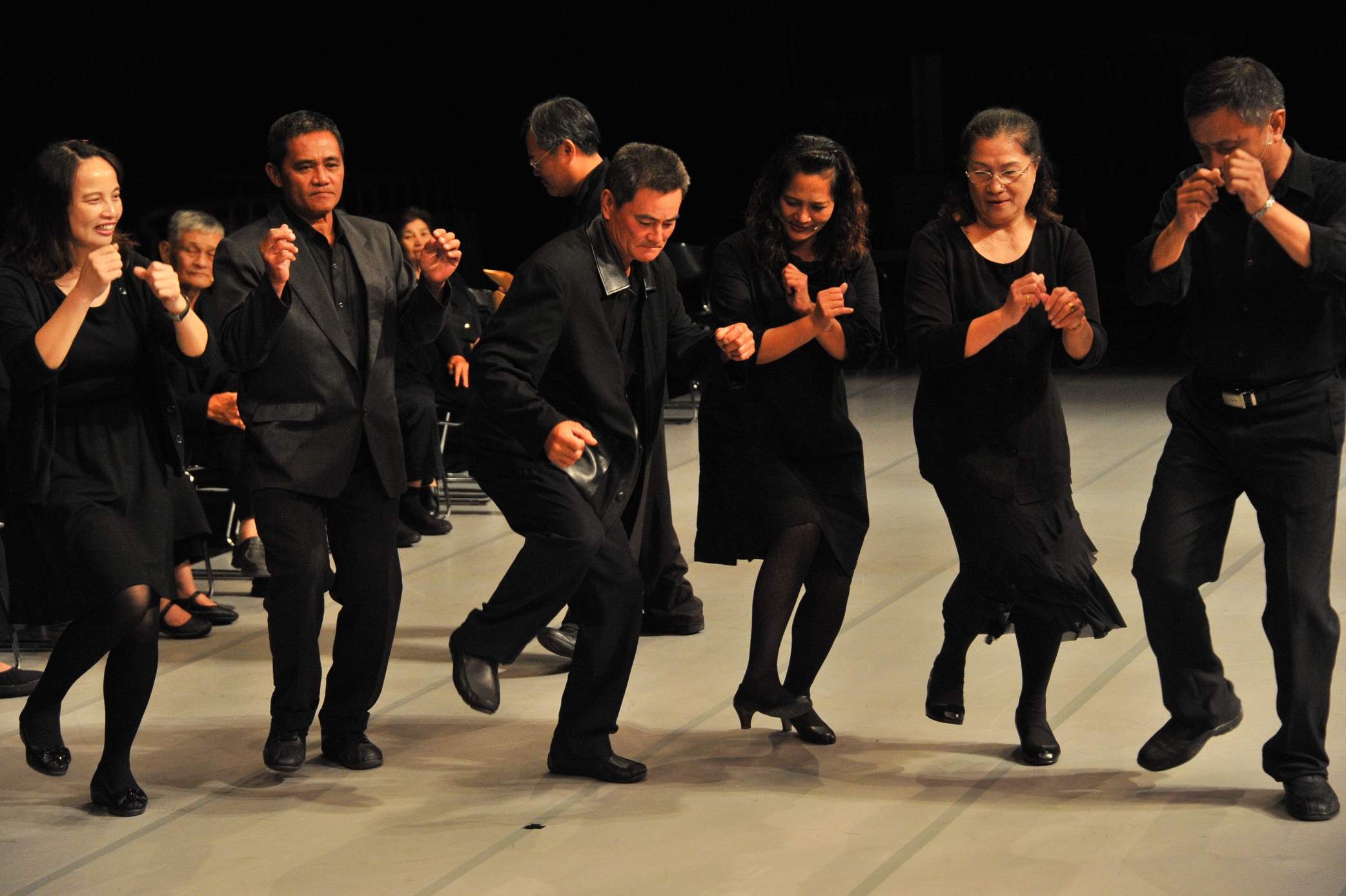迄今成立十八週年的杵音文化藝術團,長期推動地方藝文,基於保存延續台東馬蘭阿美族傳統文化,杵音文化藝術團耆老以原味歌謠吟唱出台東馬蘭部落史詩,婦女、青年們則以手足舞蹈,頌揚祖靈。
「牆上‧痕」為杵音文化藝術團與新銳導演-陳彥斌,首次合作之作品,嚐試將馬蘭複音音樂結合族人闡述個人生命經歷之方式,以音樂劇手法呈現,古謠吟唱結合個人生命故事情境流貫其中。
The Chu-Yin Culture and Arts Troupe has been established for eighteen years. It has been promoting the local art and cultural movements basing on the intention to preserve and maintain the Amis traditional culture. By singing the epic songs of the Taitung Malan Amis traditional culture, Chu-Yin elders present the authentic folk music while the women and young people dance along to pray to the ancestors’ spirits.
“Mailulay: Traces on the Wall” was the first work that Chu-Yin cooperated with the cutting-edge director, Chen, Yan-Bin. The play intends to elaborate each tribal person’s life experience by presenting Malan polyphonic music. The old folk songs engage each performer’s life stories on the stage.
杵音文化藝術團 The Chu-Yin Culture and Arts Troup
吟唱東臺灣傳統部落故事,帶領大家回溯阿美族的樂舞世界。
杵音文化藝術團之命名,『杵』乃象徵動力來源,是原住民生命的泉源,取其不忘本;『杵音』則象徵原住民內心欲表達的世界,使各族群透過歌舞文化的傳遞,達到互相了解、欣賞的目的。本團以『杵音』自許,期望透過最原始和最純真的演出,讓原住民傳統歌舞文化能不斷地延續傳承。
迄今成立十八週年的杵音文化藝術團,長期推動地方藝文,基於保存延續台東馬蘭阿美族傳統文化,杵音文化藝術團耆老以原味歌謠吟唱出台東馬蘭部落史詩,婦女、青年們則以手足舞蹈,頌揚祖靈。
To sing the traditional tribal stories of the Eastern Taiwan, to recall the Amis’ joyful dancing world.
The Chu-Yin Culture and Arts Troupe is named after “chu” (the traditional Amis farming tool, “a pestle”), which symbols the source of power and the life spring of the indigenous people, in hope of not forgetting about their roots. Chu-Yin represents how the aboriginal people desire to express outwards from their inner souls. Altogether, tribes aim to mutually understand and appreciate each other through the cultural transmission by dancing and singing, to anticipate the traditional singing and dancing culture, and to inherit and pass down the tradition via the most original and purest performances.
The Chu-Yin Culture and Arts Troupe has been established for eighteen years. It has been promoting the local art and cultural movements basing on the intention to preserve and maintain the Amis traditional culture. By singing the epics of the Taitung Malan villages, Chu-Yin elders present the authentic folk songs while the women and young people dance along to pray to the ancestors’ spirits.
郭子雄
高淑娟
呂鈺秀
高淑娟
陳彥斌
陽順英、李原信、汪寶連、豐福明、吳葉枝、 張金次、羅龍美、顏多加、曾光復
林庭宇
蔣美玲、高周美
羅瑞華、陳璽伍、宋敬苓、高淑美
陽順英、李原信、汪寶連、豐福明、吳葉枝、張金次、 羅龍美、顏多加、曾光復、莊淑英、陽玲美、森萬得、柳惠美、 黃愛花、高淑娟、郭美玉、陳正美、李阿順、方獻譽、 陽昇宏、方信發、林明亮、郭建宏、黃世川、孫
臺東縣政府文化處 藝文中心演藝廳
關鍵字
- 戲劇
- 原住民
評審談作品
這是一齣關於悼逝與追憶、壓迫與反壓迫的敘事歌篇。
入圍理由 Reason for Nomination
這是一齣關於悼逝與追憶、壓迫與反壓迫的敘事歌篇。一反原住民音樂常見的傳統表現形式,舞台上布置了一幕告別式場景,彷彿透過死亡的聯繫,口述與歌唱,族人記憶、家族情感、自我認同才得以訴說。然而,真實場景同時是:空缺的椅子(年輕人不在家鄉)、被消音的話語(只見影像,聽不見聲音)、試圖重建卻充滿塗抹、改寫、流徙痕跡的記憶;對比前景「國家的聲音」如此宏大,「不被聽見」、時續時斷的族語的聲音,暗示了原住民被剝奪的話語權。不僅是馬蘭部落天籟歌聲的傳達,「空缺的聲音」反轉為控訴壓迫的動能,《牆上。痕Mailulay》在聲音、身體及空間布署的強烈隱喻下,提出了一次委婉又嚴厲的政治批判。提名觀察人—紀慧玲
This work was a musical narrative about mourning and remembering losses. Contrary to the traditional form of indigenous music performance, the stage was decorated as a memorial service, as if the memory of the ethnic community could only be related through such a ceremony. However, the real setting was empty chairs (youths were absent from home), silenced words (images without sounds), and memories that were reconstructed yet filled with changes, revisions and a drifting past. Comparing to the sound of “the national voice,” which was loud and clear, the unheard, fragmented voices in the tribal language hinted at the deprivation of the indigenous people’s right to discourse. In addition to the performance of the divine singing from Falangaw, “the absent voices” were turned into a momentum to expose oppression. With a poignant metaphor formed by the coordination of voice, body, and space, Mailulay stated a tactful yet severe political criticism. (Commentator: CHI Hui-Ling)
年度入選獎得獎理由 Jury’s Statement on Award Winners
這是一齣關於悼逝與追憶的敘事歌篇,一反原住民音樂常見的傳統表現形式,舞台上布置了一幕告別式場景,彷彿透過追思儀式的聯繫,族群記憶才得以訴說。
消失與空缺不斷顯現於作品中,強烈的被牆上記憶痕跡所提醒,作品裡空著的椅子(人不在了,年輕人不在了)、被消聲的對話(只見影像,聽不見聲音)、被說出來試圖重新建構的記憶,如同原住民被抹消的話語權。開場以沒有實體存在,卻無所不在的國家機器廣播聲音,對比具體存在卻無法被聽見與理解的原民聲音,如此做出委婉而嚴肅的控訴。作品保留並傳承馬蘭部落歌謠,最後歌舞呈現族群強韌的生命力,令人動容。
This is a musical narrative about mourning and remembering losses. Contrary to the traditional form of indigenous music performance, the stage was decorated as a memorial service, as if the memory of the ethnic community could only be related through such a ceremony.
Disappearance and absence were continuously represented in the work, forcefully reminded by the traces on the wall. The empty chairs (absent people, absent youths), the silenced conversation (images without sounds), and the spoken and supposedly reconstructed memories all hinted at the indigenous peoples’ right of discourse. The performance commenced with a broadcast on the radio broadcast, a state apparatus that did not have a physical existence, yet was omnipresent, forming a strong contrast to the indigenous voices that had a physical existence but were unheard and uncomprehended. Hence, the work posed a tactful, yet serious accusation. In addition, this work preserved and passed on the song of Falangaw. The heartfelt and moving song and dance in the finale demonstrated the tenacious life of the indigenous people.




